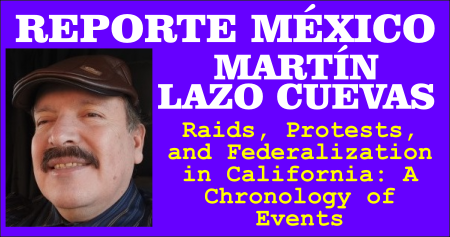09 de junio de 2025
MARTÍN LAZO CUEVAS: Raids, Protests, and Federalization in California: A Chronology of Events

by Martín Lazo Cuevas
Since June 6, 2025, the state of California—particularly the city of Los
Angeles—has been the stage for a series of significant events stemming
from federal immigration operations, social protests, and executive
decisions that have triggered a confrontation between the federal and
state governments.
The raids were carried out by agents of Immigration and Customs
Enforcement (ICE), under direct orders from the federal government.
These operations mainly targeted areas with a high concentration of
immigrant communities, such as downtown Los Angeles, Boyle Heights, and
the city of Paramount. Within the first three days, over 100 arrests
were reported. Among those detained was David Huerta, president of SEIU
California, which prompted immediate reaction from various social and
political sectors.
In response, protests were organized in different parts of the city. The
demonstrations began peacefully, with the participation of civil
organizations, human rights advocates, and general citizens. However,
during the days of June 7 and 8, isolated incidents of violence were
reported: vehicles were set on fire, businesses vandalized, and there
were confrontations with law enforcement, including the use of tear gas
in some cases.
On June 8, the President of the United States ordered the federalization
of the California National Guard, authorizing the deployment of 2,000
troops to Los Angeles. Another 2,000 troops were later added, bringing
the total to over 4,000 members of the National Guard under federal
command. In addition, 700 Marines from the 2nd Battalion, 7th Marine
Regiment based in Twentynine Palms, California, were mobilized. These
service members have not been directly involved in operations, but are
providing logistical support and protection of federal facilities.
Governor Gavin Newsom called the federalization unconstitutional and
announced a legal challenge against the federal government, arguing that
the action violates the state’s sovereignty and exceeds the
constitutional powers of the presidency. Los Angeles Mayor Karen Bass
also voiced her concerns, calling for local authorities to manage the
situation without military intervention. California Attorney General Rob
Bonta filed a civil lawsuit in federal court, invoking the Tenth
Amendment and arguing that the Insurrection Act does not apply in this
case, since no formal state of insurrection has been declared and the
state has not refused to maintain public order.
President Donald Trump defended his decision, claiming that the military
deployment prevented greater escalation of violence and that his
priority is public order and the enforcement of federal law. He also
stated that if necessary, the military presence could be extended for 60
days. In a subsequent statement, the White House reaffirmed that the
raids are part of a national effort to reinforce immigration law and
combat illegal entry into the country, and that the actions in
California are not aimed at any specific community but are based on
compliance with existing laws.
As of today, the demonstrations have decreased in intensity, though they
continue in various parts of the city. Most recent protests have
remained peaceful. Federal forces remain active in the region, although
their presence has been limited to perimeter surveillance and facility
protection. California’s lawsuit is ongoing in federal courts. It is
expected that this situation will set an important precedent regarding
the limits of federal power over states in matters of domestic security.
This episode represents one of the most tense moments between a state
government and the federal presidency in recent years. The outcome will
depend both on the legal process and the developments in the streets of
Los Angeles.



